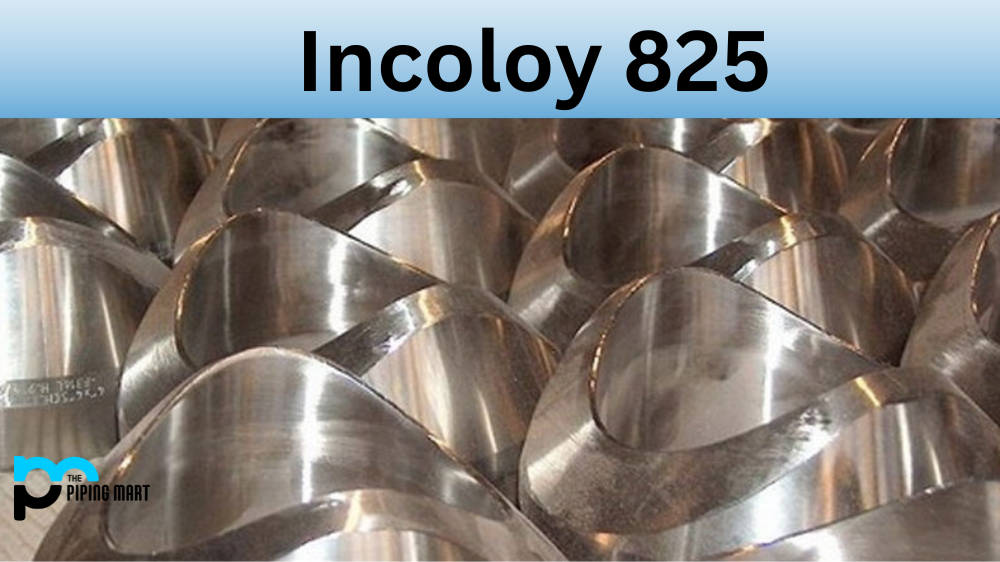Incoloy 825 is a nickel-iron-chromium alloy with exceptional resistance to stress corrosion cracking, pitting, and crevice corrosion. It is one of the most widely used alloys in the world and is highly sought after for its strength and durability. This article will examine the composition, chemical properties, mechanical properties, physical properties, uses corrosion resistance, heat resistance, heat treatment, machining, and welding of Incoloy 825.
Incoloy 825 Composition
Incoloy 825 contains nickel (37% – 46%), chromium (19% – 23%), iron (21% – 26%), molybdenum (2.5% – 3.5%), copper (1.5% – 3%) and titanium (<1%). It also contains manganese (0.50% max), silicon (<0.50%) and carbon (<0.15%).
|
Element |
% |
Element |
% |
|
Nickel |
38.0 – 46.0 |
Carbon |
0.05 max |
|
Chromium |
19.5 – 23.5 |
Manganese |
1.0 max |
|
Molybdenum |
2.5 – 3.5 |
Sulfur |
0.03 max |
|
Copper |
1.5 – 3.0 |
Silicon |
0.5 max |
|
Titanium |
0.6 – 1.2 |
Aluminium |
0.2 max |
|
Iron |
22.0 min (~33%) |
|
Incoloy 825 Chemical Properties
Incoloy 825 has excellent resistance to corrosive media, including acids such as hydrochloric acid and sulfuric acid at both room temperature and high temperatures up to 1000°F (538°C). It also offers outstanding resistance to pitting attacks from chloride ions such as sodium chloride or calcium chloride solutions at temperatures up to 1000°F (538°C). Furthermore, this alloy has excellent resistance to stress corrosion cracking in alkaline chloride solutions such as sodium hydroxide or potassium hydroxide solutions at any temperature up to 1000°F (538°C).
Incoloy 825 Mechanical properties
Incoloy 825 is a nickel-iron-chromium alloy known for its excellent mechanical properties. It is highly resistant to oxidation and corrosion and can withstand extreme temperatures without deformation, making it an ideal choice for many industrial applications. Its high tensile strength and great flexibility allow Incoloy 825 to be formed into intricate shapes while ensuring its structural integrity and maximum performance. Another attractive property of this alloy is its durability; it maintains its superior mechanical characteristics even after several years of exposure to harsh environments. Because of these advantageous properties, Incoloy 825 has become one of the most popular materials in modern engineering and industrial applications.
| Tensile Strength, min. | Yield Strength, min. | Elongation, min. | Elastic Modulus | |||
|---|---|---|---|---|---|---|
| Mpa | ksi | Mpa | ksi | % | Gpa | 106psi |
| 690 | 100 | 310 | 45 | 45 | 206 | 29.8 |
Incoloy 825 Physical Properties
Incoloy 825 has a density of 0.294 lb/in3(8 g/cm3), slightly higher than pure nickel at 0.286 lb/in3(7 g/cm3). Its melting point is 2460–2600°F (1349–1427°C), while its electrical resistivity is 49 μΩ•m at 68 °F (20 °C).
| Density | Melting Range | Specific Heat | Electrical Resistivity | ||
|---|---|---|---|---|---|
| g/cm3 | °C | °F | J/kg.k | Btu/lb. °F | µΩ·m |
| 8.14 | 1370-1400 | 2500-2550 | 440 | 0.105 | 1130 |
Incoloy 825 Uses
Incoloy 825 is used in many industries, including oil & gas production facilities, petrochemical plants; nuclear power plants; saltwater desalination plants; marine & offshore applications; pharmaceutical & medical equipment; food processing equipment; paper mills & associated equipment; automotive & aerospace components; heat exchangers & condensers; general engineering components etc.
Corrosion Resistance
Incoloy825 exhibits excellent corrosion resistance in oxidizing and reducing environments due to the high chromium content present in its composition, forming a protective oxide layer on its surface, thereby preventing further oxidation or corrosion attack from occurring on the material itself. This protective oxide layer also protects against pitting attacks from chloride ions present in solution or atmosphere. It can cause localized corrosion on metals such as aluminium or stainless steel but not on Incoloy825 due to its superior corrosion resistance properties.
Heat Resistance
Incoloy825 exhibits excellent heat resistance up to 1000°F(538°C) due to its high chromium content, preventing oxidation at these elevated temperatures, thereby maintaining the material’s integrity even under extreme conditions.
Heat Treatment
Incoloy825 is normally supplied by producers in annealed condition ready for fabrication but can be subjected to heat treatment if required depending upon application requirements. Typical heat treatments include solution annealing and ageing after welding or forming operations are completed.
Machining
Due to its high hardness and toughness levels, Incolly825 requires special machining techniques such as slow speeds, heavy feeds, high lubrication rates, and sharp tooling when being machined. It also tends to work hard during machining operations, so frequent tool changes may be necessary depending on application requirements.
Welding
Incolly815 can be welded using techniques such as TIG welding, MIG welding, or oxyacetylene welding, with suitable filler metal used depending upon application requirements. They are preheating before welding may be necessary, depending upon application requirements. After welding operations are completed, post-weld cleaning operations should also be carried out for optimum results.
Conclusion
In conclusion,incolly815 is an extremely versatile alloy with excellent mechanical properties and outstanding corrosion resistance, making it suitable for use across many industries where harsh environmental conditions exist. Its ease of fabrication and good weldability make it ideal for fabricators looking for a reliable material that can withstand extreme conditions without compromising on quality or performance. The versatile nature of this alloy makes it ideal for use across many applications where extreme conditions exist, making it one of the most popular alloys currently available on the market today.

Abhishek is a seasoned blogger and industry expert, sharing his insights and knowledge on various topics. With his research, Abhishek offers valuable insights and tips for professionals and enthusiasts. Follow him for expert advice on the latest trends and developments in the metal industry.




